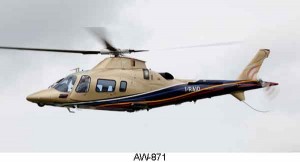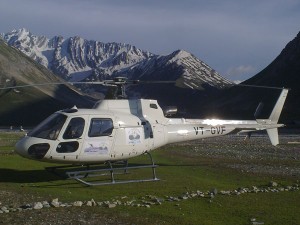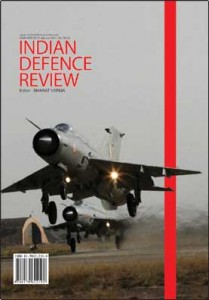“Air power is indivisible. If you split it up into compartments, you merely pull it to pieces and destroy its greatest asset – its flexibility” – Field Marshal Bernard Montgomery.
Since the beginning of thought on air power, one theoretical concept which has found general acceptance is its “indivisibility”. This concept has been viewed on two planes. In the infancy of air arms, indivisibility meant an argument in favour of a single national air force as opposed to the Army and the Navy having their own air assets and capabilities. This thought process was apt in the times when the size of the individual services was small and the technologies associated with use of the medium of air for military purposes still in a nascent stage.
With the Cold War necessitating mammoth force sizes, individual armies, naval forces and marines justified the need for air assets to be under command of each individual service. This was because the reach of these forces was envisaged as intercontinental and encompassing global missions.
“¦as a fallout of 26/11, all airlines registered in India have been made to sign an agreement with the government about immediate provision of their aircraft for airlift of passengers and cargo as required by the government.
As man ventured into space, the expression ‘air power’ metamorphosed into ‘aerospace power’. On the doctrinal plane, the concept of indivisibility also underwent a subtle change, focusing on the indivisibility of power (in air and space), of mission (strategic and tactical), and of operations (nuclear or conventional). On yet another plane is the question often asked: Is civil aviation of a nation indivisible from that nation’s capabilities in the aerospace domain? Does civil aviation qualify to be termed a component of national aerospace power? This article addresses these questions in the Indian context.
Douhet was a proponent of the idea of universality of function which perceived an intermingling of civil and military use of air assets. According to him, “An air force has need of aircraft with average characteristics similar to those of civil aircraft”. However, his belief pertaining to the use of converted civil aircraft for military use in the interest of the economy and his confidence in the direct utilisation of civil transport aircraft in the combat appeared to lose intensity in his later years. The British were at the forefront in the evolution of concepts on air power. Post WW I. Military thought in Britain spawned the idea of subsidising the production of civil aircraft which would ply their peace time trades throughout the British dominions, but would be mustered to the nation’s military service, much like compulsory enlistment. Since those early days of air power development, evolutionary changes have taken place in the nature of its components, concepts, theories, technologies and the domain of air power has expanded to include space. The term “aerospace power” now more faithfully conveys the wherewithal it represents, in peace time and in war.
Civil Aviation and Aerospace Power
The roles of the Indian Air Force (IAF) could be enumerated as Deterrence, Punishment, Protection, Projection and Peace-time responsibilities. The first three relate directly to the conduct of armed conflict and it is difficult to assign civil aviation an associate function in these three roles. However, in the latter two roles, civil aviation aircraft can provide complementary airlift capability and thus contribute to national air power.
 In a broad sense, the recent evacuation of Indian citizens from Egypt and other Arab countries by Air India was an illustration in point. It is well known now that there was a delay in airlifting NSG commandos to Mumbai in response to the 26/11 episode. Civil aviation aircraft can make their contribution there being ever ready to carry passengers and cargo in any case.
In a broad sense, the recent evacuation of Indian citizens from Egypt and other Arab countries by Air India was an illustration in point. It is well known now that there was a delay in airlifting NSG commandos to Mumbai in response to the 26/11 episode. Civil aviation aircraft can make their contribution there being ever ready to carry passengers and cargo in any case.
Indeed, as a fallout of 26/11, all airlines registered in India have been made to sign an agreement with the government about immediate provision of their aircraft for airlift of passengers and cargo as required by the government. The formalisation of such an arrangement supports the premise that civil aviation is an essential component of national air power. The large scale chartering of Air India aircraft by the Army to provide air mobility to its troops during peace time between Delhi and stations in Jammu & Kashmir is another demonstration of civil aviation contribution to air power.
 As can be seen, commonality or similarity of aircraft types, as propounded by Douhet, are not critical to the air transportation roles. This is so because the use of civil aviation assets is not envisaged as “under command” operations but rather “in support”.
As can be seen, commonality or similarity of aircraft types, as propounded by Douhet, are not critical to the air transportation roles. This is so because the use of civil aviation assets is not envisaged as “under command” operations but rather “in support”.
Synergisng Resources
Moving on to the human resource aspect, the IAF and the air arms of the Indian Navy and the Indian Army have been providing trained manpower including pilots and more importantly, flying instructors to the civil aviation industry. The helicopter component of the civil aviation industry in India is largely flown by pilots with background of military aviation. This factor is of significance in the context of the use of civil aircraft for “missions” that involve incremental risk to the crew. Former servicemen, with their training and orientation, would be well suited for manning such flights. Not only would they be mentally prepared and pro-actively disposed towards flying such missions, but would also be better prepared than those from purely civilian stream.
“¦the IAF and the air arms of the Indian Navy and the Indian Army have been providing trained manpower including pilots and more importantly, flying instructors to the civil aviation industry.
When India was confounded by Chinese military action in 1962, civil flying clubs were overnight converted to flying schools churning out military pilots on fast track, i.e. in six months instead of the usual 12 months it took to complete their training in the normal course. This improvisation proved extremely useful for the IAF and was possible only because there existed a civil flying base to augment the IAF’s training capacity which, though adequate for normal training requirements, was unequal to the task of training a large number of pilots in a short time.
A National Air University, as is being talked about, would be a great reservoir of talent as a backup resource. In addition to meeting peacetime civil aviation requirements, its infrastructure would also represent an asset capable of quickly transforming into a military aviation training facility. The Indira Gandhi Rashtriya Uran Academy (IGRUA) is already a fine flying training institution capable of turning out pilots with not just good flying skills but also good background knowledge of aviation related professional subjects. The fact that the Academy has at its helm of affairs a seasoned IAF veteran helps. Moving away from pilots, Air Traffic Control (ATC) services in India are essentially civilian except at airports under military control. In a sense, civilian controllers represent an asset that is the backbone of air traffic management in the Indian skies.
Strategic Airlift Capability
The national carrier is usually counted first as the civil aviation asset that is components of national aerospace power. In India’s case, they are ailing and feeble. However, other airlines make up for that with their more glamorous and efficient operations. Civil aviation in India began as early as 1911. The first airline was established by Mr JRD Tata in 1932 and the total number of airlines grew to nine by 1953 when the air transport sector was nationalised and Air India and Indian Airlines gained monopoly over Indian civil aviation. The monopoly regime brought in inefficiencies which continue to haunt the two national carriers, one domestic and one international (now merged and operating under the Air India banner).
| Editor’s Pick |
The process of liberalisation which commenced in 1989 dismantled the monopolistic regime in 1994 and a large number of airlines emerged on the scene. After a false start during the late nineties, private airlines bloomed once again from 2003 onwards and have since then, pushed the national domestic carrier to the fourth place. Today there are six passenger airlines and two cargo airlines. The foregoing highlights the large potential the Indian airlines represent in terms of the capability to carry passengers and cargo within the country or abroad if the need arises.
As per DGCA, the total number of aircraft that the civil aviation industry has today inclusive of airlines and general aviation is an impressive 1141 fixed wing and 296 rotary wing. While the IAF has a strategic airlift capability represented by its IL 76 and the newly acquired C 130 J aircraft, it is not unlikely that a contingency may require additional airlift capacity across the nation and even beyond its borders. Should that need arise, the airlines could be asked to assist by making available part of their fleet to augment the air power assets of the government.
 This diversion of airliners from their primary commercial preoccupation, cannot be taken for granted because the very happenstance which necessitates it would, in all probability, also put a high premium on the airline’s available passenger (and cargo) capacity. Heightened levels of tension in the neighbourhood would lead to a sudden surge in demand for domestic travel. However, the capability is a large, extant part of national aerospace power.
This diversion of airliners from their primary commercial preoccupation, cannot be taken for granted because the very happenstance which necessitates it would, in all probability, also put a high premium on the airline’s available passenger (and cargo) capacity. Heightened levels of tension in the neighbourhood would lead to a sudden surge in demand for domestic travel. However, the capability is a large, extant part of national aerospace power.
Integrated Airspace Management
India is in the process of installing GAGAN or GPS Aided Geo Augmented Navigation, a satellite-based navigation system and will be the fourth in the world (after US, Europe and Japan) to have such a system in place. The system is being implemented by the Airports Authority of India (AAI) with technological assistance from the Indian Space Research Organisation (ISRO), both civil organisations contributing to national aerospace power. GAGAN, after its final operational phase completion, will be compatible with other Space Based Augmentation Systems such as the Wide Area Augmentation System (WAAS), the European Geostationary Navigation Overlay Service (EGNOS) and the Multi-functional Satellite Augmentation System (MSAS) and will provide seamless air navigation service across regional boundaries.
When India was confounded by Chinese military action in 1962, civil flying clubs were overnight converted to flying schools churning out military pilots on fast track”¦
The government has stated that it intends to use the experience of creating the GAGAN system to enable the creation of an autonomous regional navigation system called the Indian Regional Navigational Satellite System (IRNSS). Flight Management System based on GAGAN will then be poised to save operators’ time and money by managing climb, descent and engine performance profiles.
It will improve airport and airspace access in all weather conditions and the ability to meet environmental and obstacle clearance constraints. It will also enhance reliability and reduce delays by defining more precise terminal area procedures that feature parallel routes and environmentally optimised airspace corridors. GAGAN will also offer high positional accuracies over a wide geographical area like the Indian airspace.
These positional accuracies will be simultaneously available to civilian and military airports and will facilitate an increase in the number of functional airports. As can be seen, this largely civil aviation oriented system will have an impact not only on civil aircraft movements on civil aerodromes, but will also facilitate air movements across all the 500 plus airports that are expected to be functional in a phased manner across the country.
 Space represents a regime wherein synergies are possible between various agencies to augment national aerospace power. The nature of India’s space programme is intrinsically civilian in character. However, space based assets afford immense opportunity for complementing aviation related ventures. Apart from GAGAN, meteorological services, communications, surveillance and reconnaissance are areas in which these essentially civil assets can extend the frontiers of national aerospace power. One adjunct to any nation’s space programme is the allied capability to produce ballistic missiles; in India’s case too, its fairly well developed space programme has meant that it has a credible missile programme. The Prithvi and the Agni missiles are a veritable component of aerospace power.
Space represents a regime wherein synergies are possible between various agencies to augment national aerospace power. The nature of India’s space programme is intrinsically civilian in character. However, space based assets afford immense opportunity for complementing aviation related ventures. Apart from GAGAN, meteorological services, communications, surveillance and reconnaissance are areas in which these essentially civil assets can extend the frontiers of national aerospace power. One adjunct to any nation’s space programme is the allied capability to produce ballistic missiles; in India’s case too, its fairly well developed space programme has meant that it has a credible missile programme. The Prithvi and the Agni missiles are a veritable component of aerospace power.
Inexorable Linkage
The aviation industry in India has made impressive progress with Hindustan Aeronautics Limited in the lead. The interest in aerospace has, over the years led to two Aero Shows being held biennially so that each successive year there is at least one event. These are the Aero India held at Bangalore every odd year and the India Aviation held at Hyderabad every even year. The former is now the world’s fourth largest.
 The fact that the India Aviation is managed by the Ministry of Civil Aviation and that for Aero India 2011, the number of civil aircraft on display outnumbered those from the military, reflects the importance of the civil aviation industry in India. The inevitable conclusion is that Indian civil and military aviation are inextricably linked and civil aviation, like military aviation, is an inseparable component of national aerospace power.
The fact that the India Aviation is managed by the Ministry of Civil Aviation and that for Aero India 2011, the number of civil aircraft on display outnumbered those from the military, reflects the importance of the civil aviation industry in India. The inevitable conclusion is that Indian civil and military aviation are inextricably linked and civil aviation, like military aviation, is an inseparable component of national aerospace power.




